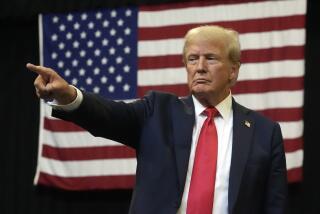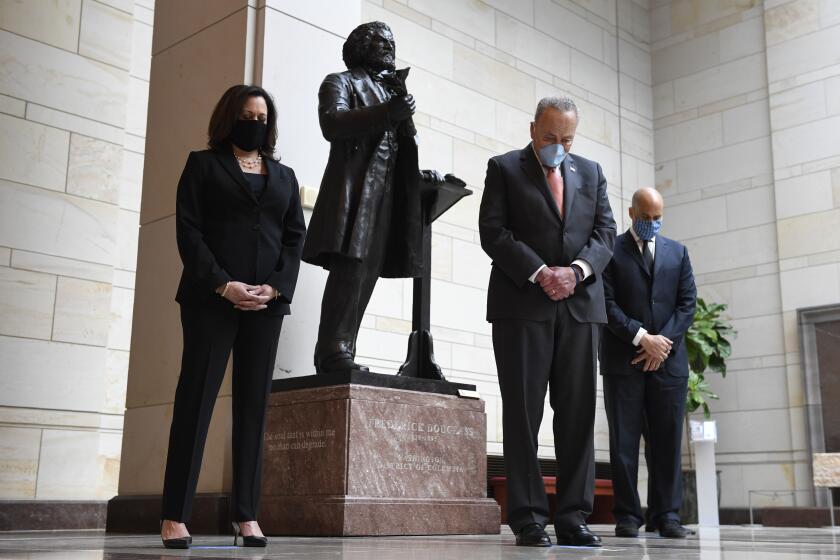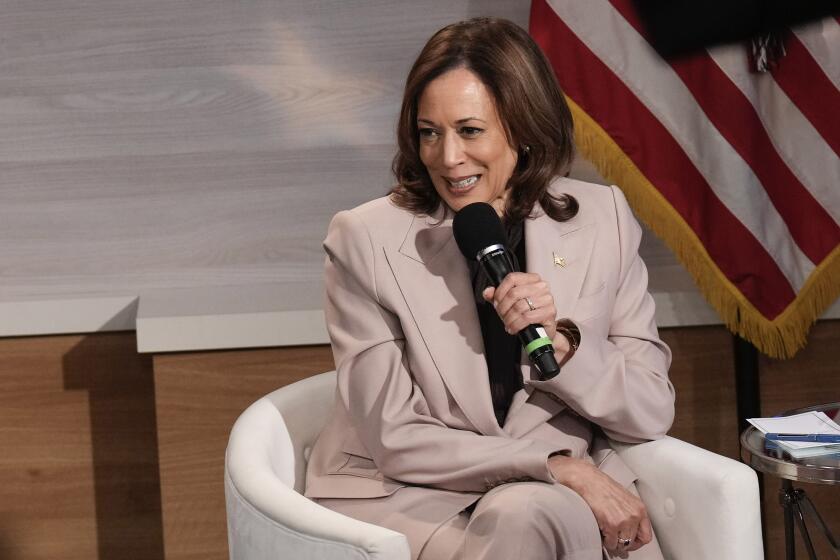Trump’s Supreme Court nominee is Neil Gorsuch, a conservative seen as likely to be confirmed
President Trump nominated federal Judge Neil M. Gorsuch on Tuesday to fill the Supreme Court seat of the late Antonin Scalia, choosing from his short list an appeals court judge from Denver seen as most likely to win Senate confirmation.
Because Scalia was a stalwart conservative, Trump’s choice is not likely to change the balance of the court. But it does set the stage for a bruising partisan fight over a man who could help determine U.S. law on gun rights, immigration, police use of force and transgender rights.
Trump made his announcement with trademark showmanship, on the grand stage of the White House’s East Room before a national audience in prime time. He also called his two finalists to the White House hours beforehand, creating an aura of mystery — or in the more critical view of some, a reality-show atmosphere — around what is traditionally a staid, sober process.
A president making such a consequential nomination after only days in office is highly unusual, and the nomination was in part a product of the partisanship that has come to define Washington in recent years. Democrats remain outraged at the GOP’s refusal to grant a vote or even a hearing to the man President Obama nominated last year to fill the vacancy, appeals court Judge Merrick Garland.
After more than a week of rapid-fire executive actions, Trump moved to deliver on a key campaign promise: to honor the legacy of Scalia by choosing someone of similar intellectual heft and ideological zeal. Perhaps no other cause motivates the Republican coalition as does preserving the balance of the high court.
GOP lawmakers, in particular Senate Majority Leader Mitch McConnell (R-Ky.), increasingly advised the president to choose a conservative least likely to further provoke a restive progressive insurgency that has sprouted in the first days of Trump’s presidency. Democrats, motivated by the groundswell of grass-roots protests, are already using multiple delaying tactics to thwart some of Trump’s Cabinet choices.
Trump took office as the least popular newcomer to the Oval Office in history, and already a majority of voters in a Gallup tracking pool disapprove of his job performance.
Vice President Mike Pence, addressing Senate Republicans during their weekly planning lunch earlier Tuesday, invited lawmakers to attend the announcement and offered assurances that they would be pleased with the selection.
Barring further changes to the Senate filibuster rules — which GOP leaders for now seem reluctant to make — Trump needs to sway at least eight Democrats to ensure his nominee is confirmed.
Liberal activists have already begun to take aim at Democrats who voted to advance some of Trump’s Cabinet appointees, and are likely to bring even greater pressure to bear given the consequential nature of recent Supreme Court decisions in preserving abortion rights, extending marriage rights to same-sex couples and twice upholding the constitutionality of the Affordable Care Act.
But from the list of 20 potential nominees that Trump had promised to choose from – compiled in direct coordination with influential conservative mainstays like the Federalist Society and the Heritage Foundation — some were more likely to provoke Senate warfare than others.
GOP leaders were particularly concerned that choosing William H. Pryor Jr., a judge on the 11th Circuit Court of Appeals who once called the decision legalizing abortion the “worst abomination in the history of constitutional law,” could prompt centrist Republican women in the Senate to withhold support.
Sen. Chuck Schumer (D-N.Y.), the minority leader, repeated Tuesday that Democrats expected “a mainstream nominee” who could get “bipartisan support.” The White House, for its part, telegraphed it would deliver.
“We’ve got an individual that I think is hopefully gonna garner widespread bipartisan support. Because I think this individual has the qualifications, and the experience, and the judicial philosophy that should win bipartisan support,” White House Press Secretary Sean Spicer told reporters.
Even as McConnell and key GOP aides advised the administration privately, the Senate leader also publicly defended the controversial position he took last year to refuse to act on Garland’s nomination. McConnell’s stance paid off, giving Trump the early opportunity to shape the high court.
It had been more than a century since a Supreme Court vacancy was filled in a presidential election year, McConnell reminded reporters Tuesday.
“This is a beginning of a four-year term. This is not in the middle of a presidential election,” he said. “There have been Supreme Court appointments in the middle of the first term for Bill Clinton, for Barack Obama. None of those four nominees was denied an up or down vote.”
More to Read
Get the L.A. Times Politics newsletter
Deeply reported insights into legislation, politics and policy from Sacramento, Washington and beyond. In your inbox three times per week.
You may occasionally receive promotional content from the Los Angeles Times.








